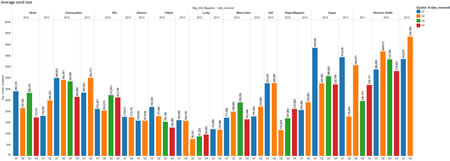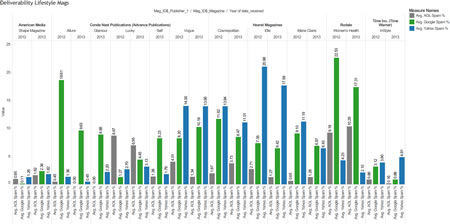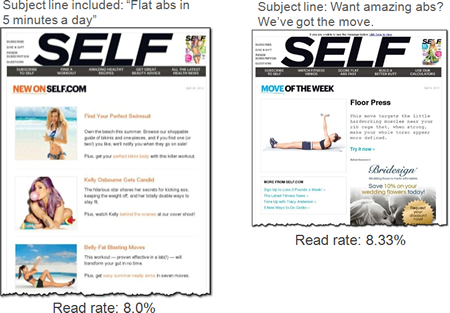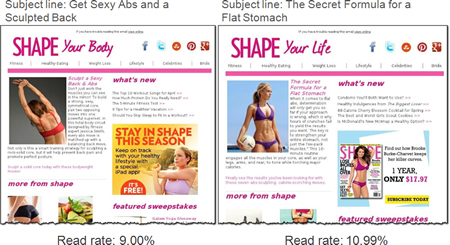How Consumer Magazines Can Use Email Marketing to Maximize ROI
Updated March 2018
Thanks to declines in circulation and advertising revenue, many of the world’s leading consumer magazines are hurting. A few years ago, we analyzed over 5,000 email newsletters across 11 leading lifestyle and fashion magazines and identified many problems these magazines were having with email. For example, we found data that indicated some top magazines had significant deliverability issues, including Gmail and Yahoo! spam rates of over 20%. Plus, there were magazines with read rates below 5%.
It was clear from our analysis that most magazines were not leveraging email marketing best practices to improve their readership engagement and other metrics surrounding circulation and advertising. And, we are still seeing these types of problems with clients and prospects today. What can be done to fix these problems? Find out what we advise here.
How Can Email Marketing Help Improve Magazine ROI?
Email can be an exceptionally effective and economical tool for consumer magazines’ marketing to increase their circulation numbers and advertising revenue. The following are two primary ways email marketing can be used to boost consumer magazines’ overall return on investment (ROI):
- Increase circulation — Email marketing should play a major role in improving a magazine’s market circulation in terms of migrating free email subscribers to becoming paid subscribers. There is a significant amount of testing and email optimization of promotional emails that can be used to drive substantial gains, especially if a magazine has done minimal testing to date.
In addition, email marketing can be used strategically with existing direct-mail efforts to:
- Reduce the cost of renewals by replacing a portion of direct mail with email
- Integrate email into the sequence of communications during the time of renewal, as small levels of renewal retention can add up quickly.
- Increase advertising — The free email newsletters provided by magazines can be used to increase reader engagement, build and maintain brand awareness, and boost website and publisher subscriber center visits. The more people coming to a magazine’s website, the more valuable its website advertising becomes. If newsletters are not adequately optimized, however, magazines are losing out on substantial gains in the email click-throughs, which translate to advertising revenue.
Each click-through from a promotional email or email newsletter equates to a visit to a magazine’s website. The following provides a way to estimate the click-through value:
A = Total number of click-throughs generated by an email
B = Average number of web pages visited per click-through
C = Average number of paid ads on each page visited
D = Cost per thousand (CPM) impressions (i.e., the amount paid by the advertiser for each 1,000 impressions)
Value of each click-through = A x B x C x (D/1,000)
For example, let’s calculate the annual value of each percentage point improvement in click-through rates and email CPM rates for a set of email newsletters sent to an average of 200,000 people for 25 sends per month (300/year):
A = 1% click-through of 200,000 x 300 = 600,000 click-throughs/year
B = 3 web pages per visit
C = 3 paid ads per page
D = $10 average CPM for email marketing
600,000 x 3 x 3 = 5.4 million additional page visits
Multiply by the CPM and divide by 1,000, and you get the value of those additional visits:
@ $10 CPM – $54,000
@ $20 CPM – $108,000
@ $40 CPM – $216,000
How big these numbers are depends upon the actual metrics for each of the marketing magazines being analyzed. So, with a little optimization, you can see how these numbers can grow quickly.
How to Market a Magazine—Are Magazines’ Free Email Newsletters Being Used Effectively as Revenue-Generating Tools?
From our data analysis below, it appears that many publications on the consumer magazines list we looked at may be using email newsletters as more of a value-added tool, rather than a strategic one. However, if the publishers’ email newsletters are to be a strategic tool to drive revenue, they must use an end-to-end model for calculating and tracking the key performance indicators (KPIs) required to gauge success regularly. The model would track extra advertising and impressions on the website that can be generated from the email publishers’ newsletters, as well as the email newsletter’s ability to migrate people to paid subscriptions. Then, there should be a clearly articulated plan for testing lists, subject lines, incentives, personalization, etc., to optimize and continually improve their email-marketing results against the KPIs. At FulcrumTech, we developed the ROI Goalsetter® tool to help with such modeling.
A Look at Leading Fashion and Lifestyle Magazines’ Email Performance
When it comes to making the most of email marketing, how are today’s consumer magazines doing? To answer that question, we compiled and analyzed data from eDataSource on 11 of today’s leading fashion and lifestyle magazines. The following table includes the publications and email-marketing publishers that we analyzed and the circulation for each:
| Table 1: Circulations of the leading fashion and lifestyle magazines FulcrumTech used in this email-marketing analysis. | |||
| Publisher | Magazine | Circulation | |
| Condé Nast | |||
| Allure | 1,108,256 | ||
| Glamour | 2,374,170 | ||
| Lucky | 1,109,835 | ||
| Self | 1,528,583 | ||
| Vogue | 1,315,304 | ||
| Time | |||
| InStyle | 1,801,701 | ||
| American Media | |||
| Shape Magazine | 1,630,901 | ||
| Rodale | |||
| Women’s Health | 1,582,687 | ||
| Hearst | |||
| Cosmopolitan | 3,023,884 | ||
| Elle | 1,135,737 | ||
| Marie Claire | 971,708 | ||
Then, we looked at many of the items we typically analyze in the FulcrumTech 10-Point Email-Marketing Assessment — a proprietary method that enables us to uncover how a publication is doing across all factors that affect email-marketing performance and ROI. In this article, we highlight our findings in regards to several of the major factors.
-
- Deliverability
First and foremost, the success of any email-marketing effort is highly dependent on deliverability—the ability to consistently get into intended recipients’ email inboxes. The junk or spam filters of web-based email services—such as Google’s Gmail or Yahoo!—may be catching them. And based upon the data we’ve analyzed, deliverability is one of the primary areas where magazines could improve their email newsletter programs significantly. If you don’t get into the inbox, you can’t get the readership or necessary clicks for the website impressions needed to generate website advertising revenue.Based on our data analysis presented in Figure 1, you can see where some publishers’ emails had regular or periodic challenges getting delivered to the inboxes. Then, if you dig down even further, you can see variations in deliverability by magazine. We can continue to drill down further to see exactly which newsletters and IP addresses may be having issues. The size and level of ongoing deliverability issues is surprising:
- A few of the Condé Nast publications had high spam rates; for example, Allure‘s average Google spam rate topped 18% in 2012, while Vogue‘s average Yahoo! spam rates were 14.00% in 2012 and 13.95% in 2013.
- Hearst’s Elle magazine had an average Yahoo! spam rate over 20% in 2012 and more than 17% in 2013.
- We also see Rodale’s Women’s Health had average Google spam rates of over 22% in 2012 and over 17% in 2013.
Another issue related to deliverability is the “foldering” features of various email service providers (ESPs). This feature lets users filter incoming emails and have them automatically placed in a specific folder or tab, such as promotional emails, email newsletters, social media, etc. If your emails and newsletters are filtered directly into certain folders or tabs of recipients, your email performance rates will be impacted. And with the recent changes to Gmail and other web-based email providers, this foldering is making it increasingly difficult to reach your intended recipient. To find out more about foldering and its potential impact on marketers, check out our recent blogs that talk about the foldering features in Microsoft’s Outlook.com and Gmail.
- List management
We don’t have access to the private information from this consumer magazine list for this article, but we can see from the data collected that some publishers tend to do email blasts.
Figure 2: Average email send size on a quarterly basis for leading fashion and lifestyle magazines. (Click to enlarge.)Although “blast” is a word we don’t like to use, it best describes what some magazine publishers are doing promotion after promotion to their lists. In other words, there are numerous promotions and cross promotions from advertisers repeatedly going to multiple lists. It appears that in many cases, little or no analysis of audience preferences is being done to determine which subscribers are interested in specific promotions or advertising. If magazine publishers improve the relevance of their promotions, their subscribers would not be as quick to go inactive or mark their emails as spam.
- Deliverability
The data we analyzed from eDataSource for this article uses “read rates” rather than the traditional “open rates” that ESPs report. A read rate is defined as the percent of emails that are marked as “read” in the email client. This varies from the graphical pixel download that is typically used to measure an email open.
So, although read rates are similar to open rates, they may differ slightly and most likely will not match a sender’s ESP tool. For example, if a subscriber opens an email and then marks it as unread, the actual email open rate may be higher than the read rate. While it may be different from the way ESPs record an email open, the read rate metric was calculated consistently across all magazines in this analysis and, hence, can be compared across all magazines.
- Email performance
As the data in Figure 3 shows, there is a wide variation in read rates among these lifestyle and fashion magazines. In the second quarter of 2012, for example, Vogue had a read rate of 6.67% compared to Shape at 11.54%. Vogue‘s read rate has remained about the same at 6.66%, while Shape dropped to 8.75%. In 2013, Elle and Glamour both had read rates of over 11%.In the battle among Self, Shape, and Women’s Health, Shape appeared to be leading on the read-rate front. Self completed a makeover in February 2013; however, their publisher email templates did not appear to have been modified significantly at that time. Interestingly, when compared to the average read rate in the beginning of 2013 prior to the makeover, Self may have actually suffered a 13% drop in read rates following the makeover. Yet even with a new branding makeover by Self, the magazine’s read rates remained lower than Shape‘s (7.5% versus 8.7%).
We concluded that if Self could successfully address its deliverability issues, their read rates would likely increase and make up quite a bit of the gap between it and Shape. When looking at the read rates, why are some magazines’ performance so much lower than others? There are likely a number of reasons, including:
- Lack of segmentation — Most of the magazines appeared to be sending the same newsletter to every individual. The magazines did not appear to be segmenting very much based upon geography, interests, content read, previous purchases, downloads, etc. Because some of the email lists are so large, even some segmentation—and testing among those segments—would likely lead to substantial improvements in click-throughs and, over time, open rates.
- High inactive subscriber rates — Read rates appeared to be fairly low across the board and a likely culprit was the level of inactive subscribers. Those magazines performing especially poorly may have been managing lists worse than others.
Understandably, magazines do not want to pare down their inactive subscribers because they’re selling against those numbers with advertisers. But that’s why a substantial and regular list-building campaign is critical. Then, adding the new, active subscribers as the inactive ones are removed will help maintain a strong email list.
- Deliverability issues — As we discussed above, some of these publishers had significant deliverability issues. So the magazines’ actual read rates would have been much higher if all of their publisher emails got to the inboxes. These consumer magazines likely would have experienced a strong lift in their open rates if they addressed deliverability issues more proactively. And if open rates were higher, then click-through rates would also rise, resulting in more page views on the destination websites. It’s also important to note that if advertising is sold on those pages, then the additional impressions should result in more advertising revenue. For example, Elle (with a 17.6% Gmail spam rate) and Women’s Health (with a 17.3% Gmail spam rate) stood the biggest gains from addressing their deliverability issues.
- Subject lines
Open and read rates—and subsequently an email campaign’s overall performance — are largely dependent on the subject line. That’s why testing and optimizing of subject lines is so important for the success of a magazine’s email performance. If your subscribers are not motivated to open your email communications, there will be no conversion. Given the volume and frequency of emails that were sent by some magazine publishers, it appears that little testing was happening to continually improve open and click-through rates.To show how the use of slightly different terms in the subject line can have a huge impact on whether or not subscribers open an email, we compared the read rates of publisher email newsletters sent by Women’s Health, Self, and Shape that covered similar topics. Shape‘s subject line, for example, generated the most dramatic performance: “Get Sexy Abs and a Sculpted Back!” got a read rate of 9%, whereas “The Secret Formula for a Flat Stomach” apparently resonated better with Shape‘s audience, resulting in a 10.99% read rate.
Also note that the performance of similar content across the magazines varied widely, from a read rate of 5.74% for Women’s Health up to 10.99% for Shape. There are various reasons to explain the differences, including:
- The impact and extent to which the terms actually resonated in that market
- One magazine may have had better, higher-quality lists for that specific campaign
- The preview pane presented in each may have been significantly different, causing one to perform better than another.
There are certainly many factors that could have affected these results, but suffice to say that there are clear opportunities for consistent, proactive testing of subject lines, creative design, preview panes, copy, offers, incentives, etc., to drive increasingly better results. With one recent project we did for a publisher, for example, after three rounds of a well-orchestrated set of optimization tests, we achieved a 62% increase in the open rates and an 87% increase in revenue.
If you’re looking for ways to optimize and improve your email-marketing performance, drive conversions, and boost ROI, FulcrumTech can help. Email us or give us a call at 215-489-9336 to learn about our 10-Point Email-Marketing Assessment that can give you a prioritized list of what you can do to improve performance of your email newsletter program.
- Email Deliverability — What You Need to Know about Getting Your Emails to the Inbox
- How to Minimize the Impact of Email Auto-Filters on Your Email-Marketing ROI
- 7 Key Strategies for Avoiding the Gmail Spam Filter
- How to Deal with Yahoo Email Delivery Issues
- Email Segmentation — 5 Tips for Segmenting Your Email Lists to Drive More Conversions
- The Key to Subject Line Success: Testing, Not Guessing





